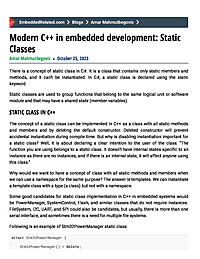
NULL pointer protection with ARM Cortex-M MPU
This post explains how you can set up the ARM Cortex-M MPU (Memory Protection Unit) to protect thy code from dragons, demons, core dumps, and numberless other foul creatures awaiting thee after thou dereference the NULL pointer.
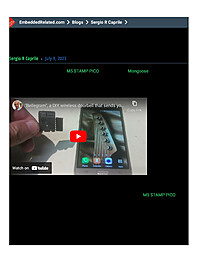
Bellegram, a wireless DIY doorbell that sends you a Telegram message
A wireless button that uses the M5 STAMP PICO and Mongoose to send a Telegram message when pressed. The code is written in C

Bit-Banged Async Serial Output And Disciplined Engineering
This post covers implementing asynchronous serial output directly on a GPIO with bit-banging. This can be a valuable debug tool for getting information out of a system. It also covers disciplined engineering, using the bit-banging module as an example and template you can apply to other projects.
Getting Started With Zephyr: Kconfig
In this blog post, we briefly look at Kconfig, one of the core pieces of the Zephyr infrastructure. Kconfig allows embedded software developers to turn specific subsystems on or off within Zephyr efficiently and control their behavior. We also learn how we can practically use Kconfig to control the features of our application using the two most common mechanisms.

An Iterative Approach to USART HAL Design using ChatGPT
Discover how to leverage ChatGPT and an iterative process to design and generate a USART Hardware Abstraction Layer (HAL) for embedded systems, enhancing code reusability and scalability. Learn the step-by-step journey, improvements made, and the potential for generating HALs for other peripherals.

Modern C++ in Embedded Development: (Don't Fear) The ++
While C is still the language of choice for embedded development, the adoption of C++ has grown steadily. Yet, reservations about dynamic memory allocation and fears of unnecessary code bloat have kept many in the C camp. This discourse aims to explore the intricacies of employing C++ in embedded systems, negotiating the issues of dynamic memory allocation, and exploiting the benefits of C++ offerings like std::array and constexpr. Moreover, it ventures into the details of the zero-overhead principle and the nuanced distinctions between C and C++. The takeaway? Armed with the right knowledge and a careful approach, C++ can indeed serve as a powerful, safer, and more efficient tool for embedded development.

Moulding the Embedded Systems Engineers of Tomorrow: Adapting to a Constantly Transforming Technological Terrain
Embedded systems engineers, previously focused on device architecture, are now steering the digital era, encompassing firmware, software, complex silicon, and cloud computing. To keep pace, mastery in new areas like cybersecurity, artificial intelligence (AI), machine learning (ML), and cloud technologies is critical. In today's highly connected world, security is foundational to design, necessitating knowledge in encryption, secure coding, and data protection laws. Additionally, expertise in AI and ML is essential for managing vast global data, requiring understanding of ethical implications and effective system design for data analysis. The advent of cloud technology mandates learning about cloud architectures and data security. In this fast-paced field, continuous learning and adapting these new skills is the key to staying relevant and spearheading future advancements.
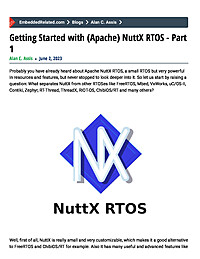
Getting Started with (Apache) NuttX RTOS - Part 1
NuttX RTOS is used in many products from companies like Sony, Xiaomi, Samsung, Google/Fitbit, WildernessLabs and many other companis. So, probably you are already using NuttX even without knowing it, like the you was using Linux on your TV, WiFi router more than 10 years ago and didn't know too! Today you will have the chance to discover a little bit of this fantastic Linux-like RTOS! Are you ready? So, let's get started!

Working with Strings in Embedded C++
This article discusses the use of strings in embedded systems. It explains how the need for and use of strings in embedded systems has changed with the advent of cheaper, full graphic displays and the growth of the ‘Internet of Things’ (IoT). The article also covers character literals, C-Strings and string literals, and the difference in memory models between them. It also highlights the safety and security issues that arise from using strings in embedded systems. Finally, it explains how C++11 introduced a Raw string literal type that is useful for storing file paths or regular expressions.
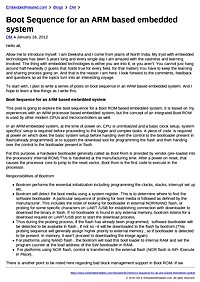
Boot Sequence for an ARM based embedded system
Hello all, Allow me to introduce myself. I am Deeksha and I come from plains of North India. My tryst with embedded technologies has been 5 years long and every single day I am amazed with the vastness and learning involved. The thing with...

Getting Started With Zephyr: Bluetooth Low Energy
In this blog post, I show how to enable BLE support in a Zephyr application. First, I show the necessary configuration options in Kconfig. Then, I show how to use the Zephyr functions and macros to create a custom service and characteristic for a contrived application.
C to C++: 5 Tips for Refactoring C Code into C++
The article titled "Simple Tips to Refactor C Code into C++: Improve Embedded Development" provides essential guidance for embedded developers transitioning from C to C++. The series covers fundamental details necessary for a seamless transition and emphasizes utilizing C++ as a better C rather than diving into complex language features. The article introduces five practical tips for refactoring C code into C++. Replace #define with constexpr and const: Discouraging the use of #define macros, the article advocates for safer alternatives like constexpr and const to improve type safety, debugging, namespaces, and compile-time computation. Use Namespaces: Demonstrating the benefits of organizing code into separate logical groupings through namespaces, the article explains how namespaces help avoid naming conflicts and improve code readability. Replace C-style Pointers with Smart Pointers and References: Emphasizing the significance of avoiding raw pointers, the article suggests replacing them with C++ smart pointers (unique_ptr, shared_ptr, weak_ptr) and using references

Getting Started with (Apache) NuttX RTOS - Part 1
NuttX RTOS is used in many products from companies like Sony, Xiaomi, Samsung, Google/Fitbit, WildernessLabs and many other companis. So, probably you are already using NuttX even without knowing it, like the you was using Linux on your TV, WiFi router more than 10 years ago and didn't know too! Today you will have the chance to discover a little bit of this fantastic Linux-like RTOS! Are you ready? So, let's get started!

Review: Embedded Software Design: A Practical Approach to Architecture, Processes, and Coding Techniques
Introduction Full disclosure: I was given a copy of this book to review. Embedded Software Design: A Practical Approach to Architecture, Processes, and Coding Techniques, by Jacob Beningo, is an excellent introduction to strategies for...

Donald Knuth Is the Root of All Premature Optimization
This article is about something profound that a brilliant young professor at Stanford wrote nearly 45 years ago, and now we’re all stuck with it. TL;DR The idea, basically, is that even though optimization of computer software to execute...

From bare-metal to RTOS: 5 Reasons to use an RTOS
Developers can come up with amazing and convoluted reasons to not use an RTOS. I have heard excuses ranging from they are too expensive (despite open source solutions) all the way to they aren’t efficient and use too much memory. In some...

Lost Secrets of the H-Bridge, Part III: Practical Issues of Inductor and Capacitor Ripple Current
We've been analyzing the ripple current in an H-bridge, both in an inductive load and the DC link capacitor. Here's a really quick recap; if you want to get into more details, go back and read part I and part II until you've got equations coming...
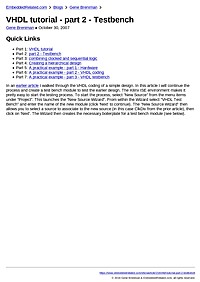
VHDL tutorial - part 2 - Testbench
[quicklinks]In an earlier article I walked through the VHDL coding of a simple design. In this article I will continue the process and create a test bench module to test the earlier design. The Xilinx ISE environment makes it pretty easy to start...







